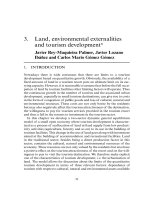THE ECONOMICS OF MONEY,BANKING, AND FINANCIAL MARKETS 455
Bạn đang xem bản rút gọn của tài liệu. Xem và tải ngay bản đầy đủ của tài liệu tại đây (32.19 KB, 1 trang )
CHAPTER 16
The Money Supply Process
423
Another way of thinking about this equation is to recognize that it reveals the
amount of the monetary base needed to support the existing amounts of currency
and chequable deposits.
To derive the money multiplier formula in terms of the currency ratio c and the
desired reserve ratio, we rewrite the last equation, specifying C as c D:
MB
(c
(c
D)
r)
(r
D
D)
We next divide both sides of the equation by the term inside the parentheses to
get an expression linking chequable deposits D to the monetary base MB:
D
1
c
(3)
MB
r
Using the definition of the money supply as currency plus chequable deposits
(M
C
D) and again specifying C as c
D
M
(c
(1
D)
c)
D
D
Substituting in this equation the expression for D from Equation 3, we have
M
1
c
c
r
( 4)
MB
Finally, we have achieved our objective of deriving an expression in the form of our
earlier Equation 2. As you can see, the ratio that multiplies MB is the money multiplier that tells how much the money supply changes in response to a given change
in the monetary base (high-powered money). The money multiplier m is thus
1 c
m
(4)
c r
It is a function of the currency ratio set by depositors c and the desired reserve
ratio set by banks r.
Intuition
Behind the
Money
Multiplier
To get a feel for what the money multiplier means, let us construct a numerical
example with realistic numbers for the following variables:
r
C
D
M
desired reserve ratio 0.05
currency in circulation $40 billion
chequable deposits $160 billion
money supply (M1 ) C D $200 billion
From these numbers we can calculate the value for the currency ratio c:
c
$40 billion
$160 billion
0.25
The resulting value of the money multiplier is
1 0.25
1.25
m
0.25 0.05
0.3
4.2
The money multiplier of 4.2 tells us that given the behaviour of depositors as represented by c
0.25 and banks as represented by r
0.05, a $1 increase in the
monetary base leads to a $4.20 increase in the money supply.









